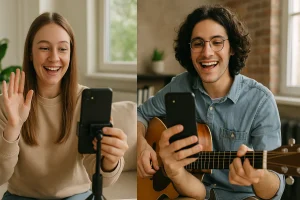In today’s digital-first world, music fandom is being redefined, not by industry gatekeepers, but by communities of passionate individuals using their voices to participate in the creative process. These individuals are more than fans; they are collaborators, creators, and culture-shapers.
Welcome to the world of fansqingers, a growing digital phenomenon that’s changing how we connect with music, artists, and each other. But what exactly is a fansqinger? Where did this trend originate, and why is it gaining such momentum in modern music culture?
This article explores the origins, psychology, cultural significance, and future of fansqingers in the global digital ecosystem.
Who Is Fansqinger and Why Is the Term Gaining Attention Online?

The term fansqinger is a creative fusion of the words fan and singer, possibly influenced by the notion of questioning or engagement. It defines individuals who love music so passionately that they become active participants, not just listeners, but singers, creators, and collaborators.
These are fans who cover songs, remix them, duet with their favourite artists on social media, and share their love of music with others in digital spaces. The fansqinger doesn’t merely consume content; they create it. This unique identity is at the intersection of digital culture, social media, and grassroots creativity.
The reason fansqinger is attracting attention is because it represents a shift, from passive appreciation to active engagement, redefining what it means to be a music fan in the 21st century.
What Inspired the Rise of Fansqingers in the Digital Music Landscape?
The rise of fansqingers can be attributed to a perfect storm of cultural and technological shifts. From improved mobile technology to widespread internet access and pandemic-induced digital immersion, several forces have shaped this trend.
- Lockdown Creativity: During lockdowns, many turned to singing and videos for self-expression and connection.
- Social Media Ecosystem: TikTok and Instagram made singing trends, duets, and challenges go viral.
- Low Barrier to Entry: Anyone with a smartphone can now record and share music easily.
- Community Recognition: Supportive online fans reward creativity with likes, shares, and comments.
As a result, fansqinging has become more than a trend; it’s an inclusive global movement.
How Do Fansqingers Redefine the Relationship Between Artist and Fan?

Traditionally, the relationship between artists and fans was one-directional, artists created, fans consumed. Fansqingers disrupted that model by creating a two-way bridge.
Artists now actively respond to fansqinger content. Some repost fan covers, while others invite their fans to participate in live duets or even feature them in official releases. This collaborative spirit has changed the dynamics of audience interaction.
From Appreciation to Co-Creation
Fansqingers blur the line between audience and artist. Their performances not only celebrate the music they love but contribute to its spread and emotional impact. Whether through duets, harmonies, or remixes, fansqingers make the music their own.
Artists Embracing Fansqingers
Modern musicians increasingly view fansqingers as partners in promotion. Fan-made content often goes viral, introducing new listeners and breathing life into older tracks. For artists, this engagement translates to loyalty, visibility, and authenticity.
What Makes the Fansqinger Movement Unique in Today’s Music World?
At its core, the fansqinger movement stands out because of its authenticity, inclusivity, and emotional depth. It’s not about chasing perfection; it’s about using music to connect, express, and heal.
- Emotion Over Perfection: Fansqingers are celebrated for their sincerity, not just technical talent. A shaky voice singing with feeling can resonate more than a studio-polished vocal.
- Global Inclusivity: Fansqingers span all backgrounds, languages, and age groups. Music becomes a shared language that unites people worldwide.
- Supportive Ecosystem: In this community, judgement is replaced by encouragement. Every voice matters, and every contribution adds value.
This emotional depth and cultural diversity give fansqingers a unique place in the modern music world, one rooted in creativity, vulnerability, and community spirit.
How Are Fansqingers Using Technology to Amplify Their Voices?
Technology plays a vital role in enabling the fansqinger revolution. It levels the playing field by making tools, platforms, and reach accessible to virtually anyone.
DIY Tools Powering Professional Content
Today’s fansqingers have access to:
- Mobile recording apps
- AI-powered vocal filters
- Harmony generators
- Beat sync and remix apps
These tools help fansqingers produce music-like content without needing a physical studio, giving rise to a wave of grassroots digital creators.
Social Platforms as Performance Arenas
Social media platforms, particularly those built around short-form content, have become the main stage for fansqingers. Features like:
- TikTok’s Duet and Stitch functions
- Instagram’s Reels and Live collabs
- YouTube’s Shorts and community tabs
These empower fansqingers to collaborate, remix, and gain exposure in front of global audiences.
Why Is Being a Fansqinger About More Than Just Music?

While music remains central, the fansqinger movement is deeply rooted in emotional expression, identity, and mental well-being. Many fansqingers report increased confidence, reduced stress, and a strong sense of community through their participation.
This movement is about finding a voice, sometimes literally. It’s about connection in an often-isolated online world. Singing becomes a tool for healing, expression, and empowerment.
Communities of fansqingers often extend support during difficult times. Through music, they share encouragement, hope, and solidarity. In essence, fansqinging becomes not just a creative outlet, but a form of self-care.
What Challenges Do Fansqingers Face and How Do They Overcome Them?
Like all creators, fansqingers navigate various hurdles. Yet, the resilience of their communities and the accessibility of tools help them thrive in the face of challenges.
| Challenge | Community Solutions |
|---|---|
| Performance anxiety | Private rehearsals, small group shares, community support |
| Negative feedback | Positive engagement policies, peer reinforcement |
| Copyright restrictions | Use of platform-cleared audio or royalty-free content |
| Limited resources | Free tools, shared templates, tutorial sharing |
Fansqingers have cultivated an environment where mistakes are part of the process and learning is collaborative. Instead of competition, there is celebration, especially of those just beginning their journey.
How Can Someone Become a Fansqinger and Join the Movement?

You don’t need a label, manager, or vocal coach to become a fansqinger. All you need is a passion for music and the courage to share your voice.
Here’s how anyone can get started:
- Pick a Song: Choose a track that moves you, emotionally or rhythmically.
- Record Your Voice: Use your phone or a basic microphone setup.
- Edit (If Needed): Lightly polish with free mobile apps or web tools.
- Upload to Social Media: Use platforms like TikTok, Instagram, or YouTube.
- Join the Conversation: Hashtag your post, comment on others, and build connections.
Over time, you’ll develop your style, gain confidence, and maybe even inspire others to begin their own fansqinger journey.
What Is the Long-Term Impact and Future of the Fansqinger Culture?
The fansqinger movement is not just a momentary trend, it’s a fundamental transformation in how we interact with music. As the internet becomes more participatory, fansqingers will become central to how music is shared, adapted, and loved.
- Music Industry Evolution: Labels and artists are creating official campaigns around fansqingers, from fan duets to remix contests.
- Technological Expansion: Tools like AI-generated harmony layers and virtual reality concerts will enhance participation.
- Cultural Shift: Fansqingers are turning music into a two-way conversation, challenging the exclusivity of performance and bringing back the communal joy of singing.
The future of music belongs not just to artists, but to everyone who chooses to sing along.
Conclusion
The rise of the fansqinger reflects a deeper truth about our digital age, creativity thrives when people are given the space and tools to express themselves.
These passionate individuals aren’t waiting for permission to perform. They’re claiming their space, connecting globally, and reshaping how we think about music, fandom, and art.
Whether you’re a shy bedroom singer or a confident performer, there’s room in the fansqinger movement for you. So the next time you sing along to your favourite song, consider this: you’re not just a fan. You might just be a fansqinger.
FAQs About Fansqingers
What motivates people to become fansqingers instead of traditional listeners?
For many, it’s about self-expression and emotional connection. Fansqinging offers a more immersive experience than passive listening.
Do fansqingers influence music charts or artist popularity?
Yes, viral fan performances often boost song streams and visibility, indirectly impacting chart performance.
How are fansqingers different from general cover artists?
While cover artists often focus on performance quality, fansqingers emphasise community, emotion, and participation.
Are fansqingers only focused on pop music, or other genres too?
Fansqingers span every genre, from classical to K-pop, with creativity being the only common thread.
Is there a code of conduct or etiquette among fansqingers online?
Generally, respect, support, and constructive feedback form the unspoken code within these communities.
Can fansqingers collaborate internationally?
Absolutely. Fansqingers from different countries often duet or remix each other’s work, fostering global connections.
How do schools or youth programmes engage with fansqinger culture?
Some educational initiatives incorporate fansqinger methods to encourage creativity, confidence, and digital engagement among students.


